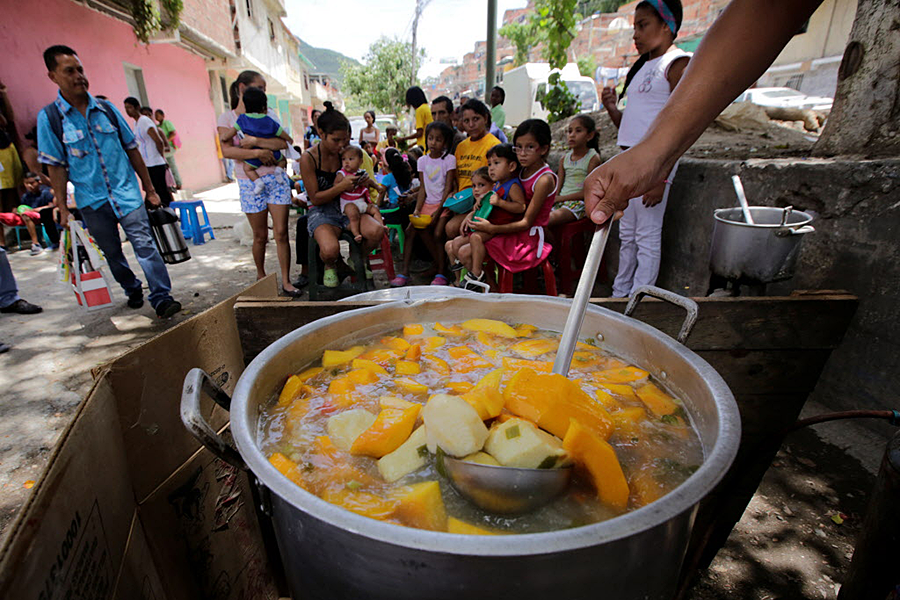In Venezuela, let them eat their own fruits and vegetables?
To answer how Venezuela could solve its persistent food shortage, President Nicolás Maduro recounted how he and his wife grew pumpkins on their patio for a soup that tasted “like heaven.”
“He who learns to cultivate in his city, his school, his university, his factory, in his communal space ... cultivates another form of faith in life,” said Mr. Maduro, when he promoted the “Great Agro-Venezuelan Mission.” “We need to plant to ensure food sovereignty.”
Months later, Venezuelans’ responses to the urban farming program are lukewarm. Some city farmers acknowledge the time they spend in their gardens has reduced their time waiting in grocery lines on the street, in addition to improving their diets. However, economists and Venezuelans have said the program has been stifled by a lack of both government support and arable land in the country underutilized, as well as the government ignoring the root of the country’s economic woes.
Twitter has become a platform for Venezuelans to voice their frustration, The Washington Post reports.
“Urban Farming in Venezuela. Thanks to @Nicolas Maduro” read one tweet accompanied by a photograph of a man and a dog sifting through trash, “a common sight in Caracas as food supplies dwindle and black market prices soar,” writes the Post’s Sofia Barbarani.
“BBC Venezuela report has Chavistas explaining how they're going to feed people, grow medicine, through urban farming. No, really,” wrote another Twitter user.
Under the program, Maduro and the Ministry of Urban Agriculture encouraged city dwellers to grow fruits and vegetables on balconies, roofs, and barracks, as the country faces a major economic crisis and widespread food shortages. The country’s goal is to grow 3,500 metric tons of fruits, vegetables, and herbs this year, with the ministry suggesting citizens can produce 20 kilos (nearly 45 pounds) of fruits and vegetables on just one meter of land.
But from May to July, some 135,000 Venezuelans produced 273 metric tons in urban settings, according to the first government data since the push. Moreover, only about 8 square miles (21 square kilometers) have been planted since the project was started eight months ago, far short of the 4,600-square-miles (12,000 square kilometers) the ministry promised to plant in the first 100 days.
Part of the problem is a lack of government support and mismanagement, critics say. The Maduro administration promised to invest $300,000 in seeds, equipment, and education projects, and to assist with logistics, according to the Post. But critics have said the project has targeted the wrong spaces. According to economists, swathes of arable land in the country are underused, since much of it was expropriated under past socialist leaders. Water and electricity shortages have also made it difficult for farmers to tend to existing crops. As city farmers search for ways around these challenges, food shortages and inflation continue in Venezuela.
“It’s the result of many factors, including decreasing purchasing power as the cost of food goes up more quickly than wages, and years of policies to keep food prices low for consumers, reducing incentives for private production,” The Christian Science Monitor’s Whitney Eulich and Mariana Zuñiga reported in June.
But political choices have exacerbated the situation, observers say. The government has prioritized paying off foreign debt at the expense of paying pharmaceutical companies or other industries for vital imports, or investing in the domestic production of food, which faltered over the past decade-plus of price controls and expropriations. And the Maduro administration has refused to acknowledge that it’s facing a food crisis, which means little to no international or multilateral aid has been able to trickle in to address the situation.
And the falling price of oil has exacerbated the problem for the nation.
Rising inflation and government mismanagement have led to riots and looting, a black grocery market, and concerns about malnutrition, especially among children.
Some Venezuelans do see one benefit of the program: It reduces their time on the streets of Caracas, where crime has skyrocketed.
A program like Venezuela's also has some precedence. Havana, Cuba, became the greenest city in Latin America following a sustainable agriculture program during the “Special Period” in the 1990s after the collapse of its cold war benefactor, the Soviet Union.
But Venezuela’s food problems are just one visible sign of the growing tension of the country amid its economic problems. Some economists predict that tension will eventually erupt.
That tension has already started to mount. According to the Venezuelan Observatory of Social Conflict, there were 954 protests over food shortages in the first six months of 2016, an average of five a day, 90 percent more than in 2015. At least 516 instances of looting or attempted looting occurred in the same period, according to the CBC.
"When a country has its population eating out of the garbage, then they are ready to hear other options," economist Angel Garcia Banch told the CBC.
Opposition leader Henrique Capriles has called for a recall of Maduro. But the recall was postponed until further notice, with the courts claiming electoral fraud committed by members of the opposition. Other opposition leaders have also called for hundreds of thousands of protesters to march against the government. The next large protest march is scheduled for Thursday to The Palacio de Miraflores, the presidential palace, according to the CBC.
Yet, some Venezuelans do see another added benefit to urban farming – better nutrition.
"We're not growing to fill our stomachs, but to eat better," Militza Perez, a bank worker who grows her own peppers, chard and other herbs on a roof garden, told Reuters in August.
This report contains material from Reuters.





